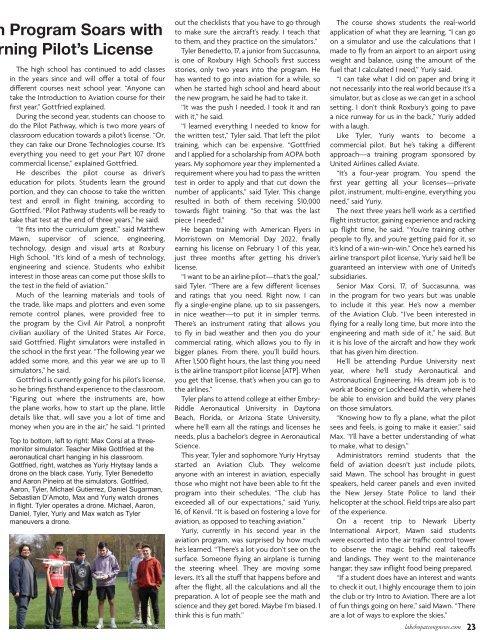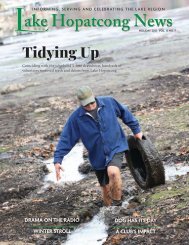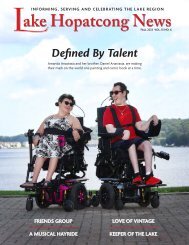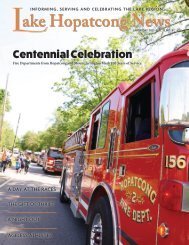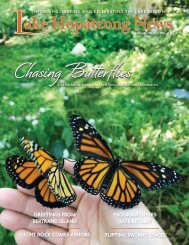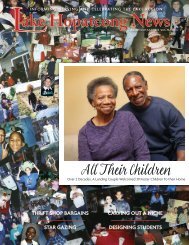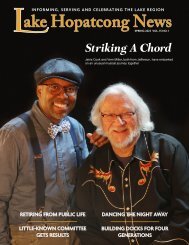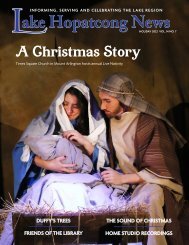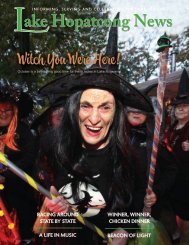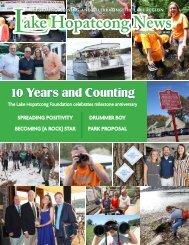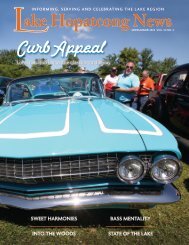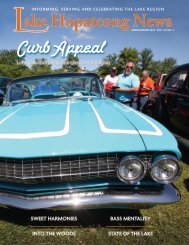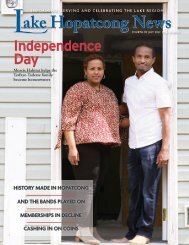Create successful ePaper yourself
Turn your PDF publications into a flip-book with our unique Google optimized e-Paper software.
Program Soars with<br />
ning Pilot’s License<br />
The high school has continued to add classes<br />
in the years since and will offer a total of four<br />
different courses next school year. “Anyone can<br />
take the Introduction to Aviation course for their<br />
first year,” Gottfried explained.<br />
During the second year, students can choose to<br />
do the Pilot Pathway, which is two more years of<br />
classroom education towards a pilot’s license. “Or,<br />
they can take our Drone Technologies course. It’s<br />
everything you need to get your Part 107 drone<br />
commercial license,” explained Gottfried.<br />
He describes the pilot course as driver’s<br />
education for pilots. Students learn the ground<br />
portion, and they can choose to take the written<br />
test and enroll in flight training, according to<br />
Gottfried. “Pilot Pathway students will be ready to<br />
take that test at the end of three years,” he said.<br />
“It fits into the curriculum great,” said Matthew<br />
Mawn, supervisor of science, engineering,<br />
technology, design and visual arts at Roxbury<br />
High School. “It’s kind of a mesh of technology,<br />
engineering and science. Students who exhibit<br />
interest in those areas can come put those skills to<br />
the test in the field of aviation.”<br />
Much of the learning materials and tools of<br />
the trade, like maps and plotters and even some<br />
remote control planes, were provided free to<br />
the program by the Civil Air Patrol, a nonprofit<br />
civilian auxiliary of the United States Air Force,<br />
said Gottfried. Flight simulators were installed in<br />
the school in the first year. “The following year we<br />
added some more, and this year we are up to 11<br />
simulators,” he said.<br />
Gottfried is currently going for his pilot’s license,<br />
so he brings firsthand experience to the classroom.<br />
“Figuring out where the instruments are, how<br />
the plane works, how to start up the plane, little<br />
details like that, will save you a lot of time and<br />
money when you are in the air,” he said. “I printed<br />
Top to bottom, left to right: Max Corsi at a threemonitor<br />
simulator. Teacher Mike Gottfried at the<br />
aeronautical chart hanging in his classroom.<br />
Gottfried, right, watches as Yuriy Hrytsay lands a<br />
drone on the black case. Yuriy, Tyler Benedetto<br />
and Aaron Pineiro at the simulators. Gottfried,<br />
Aaron, Tyler, Michael Gutierrez, Daniel Sugarman,<br />
Sebastian D’Amoto, Max and Yuriy watch drones<br />
in flight. Tyler operates a drone. Michael, Aaron,<br />
Daniel, Tyler, Yuriy and Max watch as Tyler<br />
maneuvers a drone.<br />
out the checklists that you have to go through<br />
to make sure the aircraft’s ready. I teach that<br />
to them, and they practice on the simulators.”<br />
Tyler Benedetto, 17, a junior from Succasunna,<br />
is one of Roxbury High School’s first success<br />
stories, only two years into the program. He<br />
has wanted to go into aviation for a while, so<br />
when he started high school and heard about<br />
the new program, he said he had to take it.<br />
“It was the push I needed. I took it and ran<br />
with it,” he said.<br />
“I learned everything I needed to know for<br />
the written test,” Tyler said. That left the pilot<br />
training, which can be expensive. “Gottfried<br />
and I applied for a scholarship from AOPA both<br />
years. My sophomore year they implemented a<br />
requirement where you had to pass the written<br />
test in order to apply and that cut down the<br />
number of applicants,” said Tyler. This change<br />
resulted in both of them receiving $10,000<br />
towards flight training. “So that was the last<br />
piece I needed.”<br />
He began training with American Flyers in<br />
Morristown on <strong>Memorial</strong> <strong>Day</strong> 2022, finally<br />
earning his license on February 1 of this year,<br />
just three months after getting his driver’s<br />
license.<br />
“I want to be an airline pilot—that’s the goal,”<br />
said Tyler. “There are a few different licenses<br />
and ratings that you need. Right now, I can<br />
fly a single-engine plane, up to six passengers,<br />
in nice weather—to put it in simpler terms.<br />
There’s an instrument rating that allows you<br />
to fly in bad weather and then you do your<br />
commercial rating, which allows you to fly in<br />
bigger planes. From there, you’ll build hours.<br />
After 1,500 flight hours, the last thing you need<br />
is the airline transport pilot license [ATP]. When<br />
you get that license, that’s when you can go to<br />
the airlines.”<br />
Tyler plans to attend college at either Embry-<br />
Riddle Aeronautical University in <strong>Day</strong>tona<br />
Beach, Florida, or Arizona State University,<br />
where he’ll earn all the ratings and licenses he<br />
needs, plus a bachelor’s degree in Aeronautical<br />
Science.<br />
This year, Tyler and sophomore Yuriy Hrytsay<br />
started an Aviation Club. They welcome<br />
anyone with an interest in aviation, especially<br />
those who might not have been able to fit the<br />
program into their schedules. “The club has<br />
exceeded all of our expectations,” said Yuriy,<br />
16, of Kenvil. “It is based on fostering a love for<br />
aviation, as opposed to teaching aviation.”<br />
Yuriy, currently in his second year in the<br />
aviation program, was surprised by how much<br />
he’s learned. “There’s a lot you don’t see on the<br />
surface. Someone flying an airplane is turning<br />
the steering wheel. They are moving some<br />
levers. It’s all the stuff that happens before and<br />
after the flight, all the calculations and all the<br />
preparation. A lot of people see the math and<br />
science and they get bored. Maybe I’m biased. I<br />
think this is fun math.”<br />
The course shows students the real-world<br />
application of what they are learning. “I can go<br />
on a simulator and use the calculations that I<br />
made to fly from an airport to an airport using<br />
weight and balance, using the amount of the<br />
fuel that I calculated I need,” Yuriy said.<br />
“I can take what I did on paper and bring it<br />
not necessarily into the real world because it’s a<br />
simulator, but as close as we can get in a school<br />
setting. I don’t think Roxbury’s going to pave<br />
a nice runway for us in the back,” Yuriy added<br />
with a laugh.<br />
Like Tyler, Yuriy wants to become a<br />
commercial pilot. But he’s taking a different<br />
approach—a training program sponsored by<br />
United Airlines called Aviate.<br />
“It’s a four-year program. You spend the<br />
first year getting all your licenses—private<br />
pilot, instrument, multi-engine, everything you<br />
need,” said Yuriy.<br />
The next three years he’ll work as a certified<br />
flight instructor, gaining experience and racking<br />
up flight time, he said. “You’re training other<br />
people to fly, and you’re getting paid for it, so<br />
it’s kind of a win-win-win.” Once he’s earned his<br />
airline transport pilot license, Yuriy said he’ll be<br />
guaranteed an interview with one of United’s<br />
subsidiaries.<br />
Senior Max Corsi, 17, of Succasunna, was<br />
in the program for two years but was unable<br />
to include it this year. He’s now a member<br />
of the Aviation Club. “I’ve been interested in<br />
flying for a really long time, but more into the<br />
engineering and math side of it,” he said. But<br />
it is his love of the aircraft and how they work<br />
that has given him direction.<br />
He’ll be attending Purdue University next<br />
year, where he’ll study Aeronautical and<br />
Astronautical Engineering. His dream job is to<br />
work at Boeing or Lockheed Martin, where he’d<br />
be able to envision and build the very planes<br />
on those simulators.<br />
“Knowing how to fly a plane, what the pilot<br />
sees and feels, is going to make it easier,” said<br />
Max. “I’ll have a better understanding of what<br />
to make, what to design.”<br />
Administrators remind students that the<br />
field of aviation doesn’t just include pilots,<br />
said Mawn. The school has brought in guest<br />
speakers, held career panels and even invited<br />
the New Jersey State Police to land their<br />
helicopter at the school. Field trips are also part<br />
of the experience.<br />
On a recent trip to Newark Liberty<br />
International Airport, Mawn said students<br />
were escorted into the air traffic control tower<br />
to observe the magic behind real takeoffs<br />
and landings. They went to the maintenance<br />
hangar; they saw inflight food being prepared.<br />
“If a student does have an interest and wants<br />
to check it out, I highly encourage them to join<br />
the club or try Intro to Aviation. There are a lot<br />
of fun things going on here,” said Mawn. “There<br />
are a lot of ways to explore the skies.”<br />
lakehopatcongnews.com 23


